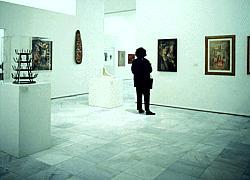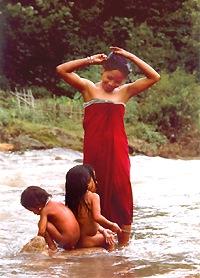|
Module 22 |
Updated: 07/20/2005 |
|
Composition: Have you ever wondered why certain paintings endure for centuries and become priceless, while others end up at garage sales? Art critics agree that the difference hinges on an elusive element called artistic talent.
In video production an understanding of cameras, lenses, etc., is fundamental. But those who never get beyond this basic understanding, as essential as that might be, never distinguish themselves. At best, they will be considered good technicians. We can make an analogy to musical performances. There are many people who can "get all the notes right." But, if the performance lacks heartfelt interpretation (emotion), we feel that something is missing, especially if we have an opportunity to hear someone who can interpret and "put themselves into" the same music. It's only after you master the basic tools of the medium and
are able to go beyond them to express your ideas in creative and even artistic ways
that your work will be considered praiseworthy - even exemplary.
A scene can be well exposed, in sharp focus, have perfect color balance, and be well lit (i.e., have good form) and still be empty of emotional meaning and impact (be void of meaningful content). If a scene in a production is striking, dramatic, or humorous, we will tend to overlook minor technical weaknesses. This leads us to the following: Content takes precedence over form. In other words, the intended message of a production is more important than things such as technical excellence or flashy embellishments. At the same time, significant technical problems-poor sound, a jittery camera, or a lens going in and out of focus-will quickly divert attention away from the message-content. When production elements call attention to themselves, either because they are poor or because they are ostentatious, attention is shifted away from content. This is especially true in dramatic television. If the content is predictable or somewhat pedestrian in nature, a director may try to hold audience attention by deluging viewers with special effects. This practice is common in some music videos, where there is competition to come up with ever-more-bizarre and far-out effects. TV series such as CSI use special effects as a kind of
"hook" to attract viewer In a series such as Friends, one of the most popular sitcoms of all time, content alone carries the series, and there is almost never a need for special effects. (Friends aired its last episode in May, 2004, but reruns will undoubtedly be broadcast for many years.)
Although we generally assume that the term "director" refers to the person's role in directing (steering) the work of production personnel, the term actually has a more important meaning: one who directs the attention of viewers. In this role the director moves from form into content and centers on skillfully and creatively using the tools of the medium to regularly direct the audience's attention to critical aspects of the message. In a sense, the director is a kind of "tour guide" for viewers.
Insert Shots and Cutaways Instead of saying, "If you will look out the window on the left of the bus, you will see..," a good director cuts to a closeup of whatever is important for the audience to see at that moment. This referred to as an insert shot, a closeup of something significant within the basic scene. The insert shot forces the audience to look at a significant aspect of the overall scene, while highlighting details that may not have been apparent. Good tour guides also help people understand things by adding
significant information along the route. Good directors do the same. This could
be considered a cutaway shot-cutting away from the central
scene to bring in related material. For example, while covering a parade, a director might cut away
to a shot of a baby sleeping peacefully in a stroller. Or a sequence showing buyers
in a busy marketplace in the Philippines might cut away to a shot of a child watching
it all as shown in the photo on the right. Enhancing the Message A major role for production tools is to enhance, amplify, or explain the message. Music is a production tool when it enhances the atmosphere, tips us off to danger, or sets the mood for romance. As we will see, lighting can suggest a cheerful atmosphere or a dark, dim, and seedy environment. Sets and props can do the same; plus, in a dramatic production they can tell us a great deal about characters-even before we meet them.
Contrast the setting shown here with starting a dramatic production with a slow pan across a bright, immaculate, airy penthouse garnished with ultramodern furniture and paintings. What does each say about the people involved? There is a saying in videography
and film: Never say it if you can show it. 
Let's say you are doing a documentary on air pollution. You could talk about how bad things are, or you could simply cut to a scene like this. Since what people see on TV typically carries much more of an impact than what they hear, you are much better off showing things rather than talking about them. In a sense, all of the
things we've been discussing can be included in the general term, composition
(the elements that compose a scene). However, for the remainder of this section
we'll concentrate on a narrower and more traditional definition of the term. Defining Composition Composition can be defined as the orderly arrangement of elements in a scene which, when taken as a whole, conveys intent and meaning. (How's that for a genuine textbook-type definition?) Television production involves both static composition and dynamic composition. Static composition covers the content of fixed images, such as paintings or still photos. Dynamic composition goes a step further and takes into consideration the effect of time-moment-to-moment change. This change can be within a single shot (including camera or talent moves), or it can apply to the sequence of scenes created through editing. By studying the most enduring
and aesthetically pleasing paintings over the centuries, as well as the most effective
film and video scenes during the past 50 years, certain artistic principles emerge.
Why not take an afternoon and go to a traditional art gallery and see if you
can draw some conclusions for yourself, or study some dramatic videos (movies) that
have won awards for cinematography.
Studying the work of
those who have achieved recognition in art and cinematography can be both enjoyable
and beneficial.
Guidelines, Not Rules
Composition is an art and not a science. If composition were totally a science, it could be dictated by a fixed set of rules and would end up being rigid and predictable, without room for creativity. Since composition is part an art, the guidelines can occasionally be broken. But when they are it's generally by someone who understands the principles and recognizes how, in the interest of greater impact, they can be successfully transcended in specific instances. When most individuals break the guidelines, it's because they are not "visually savvy." The results speak loud and clear: weak, confusing and amateurish-looking work. With all this as a background we can start looking at some specific guidelines for composition. |

 Although talent is hard to define, we do know that it goes far beyond a familiarity
with the basic elements of the medium-in this case paint, brushes and canvas-to
an ability to use the medium to create an emotional experience in the viewer.
Although talent is hard to define, we do know that it goes far beyond a familiarity
with the basic elements of the medium-in this case paint, brushes and canvas-to
an ability to use the medium to create an emotional experience in the viewer.
 attention; but, at the same time, the major emphasis remains on the story line (the
content) and, of course, the "chemistry" between principal characters.
attention; but, at the same time, the major emphasis remains on the story line (the
content) and, of course, the "chemistry" between principal characters. 
 A good example of this is an atmosphere introduction, a technique
where a director tips us off to important things about characters by introducing
us first to their surroundings.
A good example of this is an atmosphere introduction, a technique
where a director tips us off to important things about characters by introducing
us first to their surroundings.  Even
though the principles that have emerged for good composition seem rather clear,
they should always be considered guidelines and not rules.
Even
though the principles that have emerged for good composition seem rather clear,
they should always be considered guidelines and not rules.